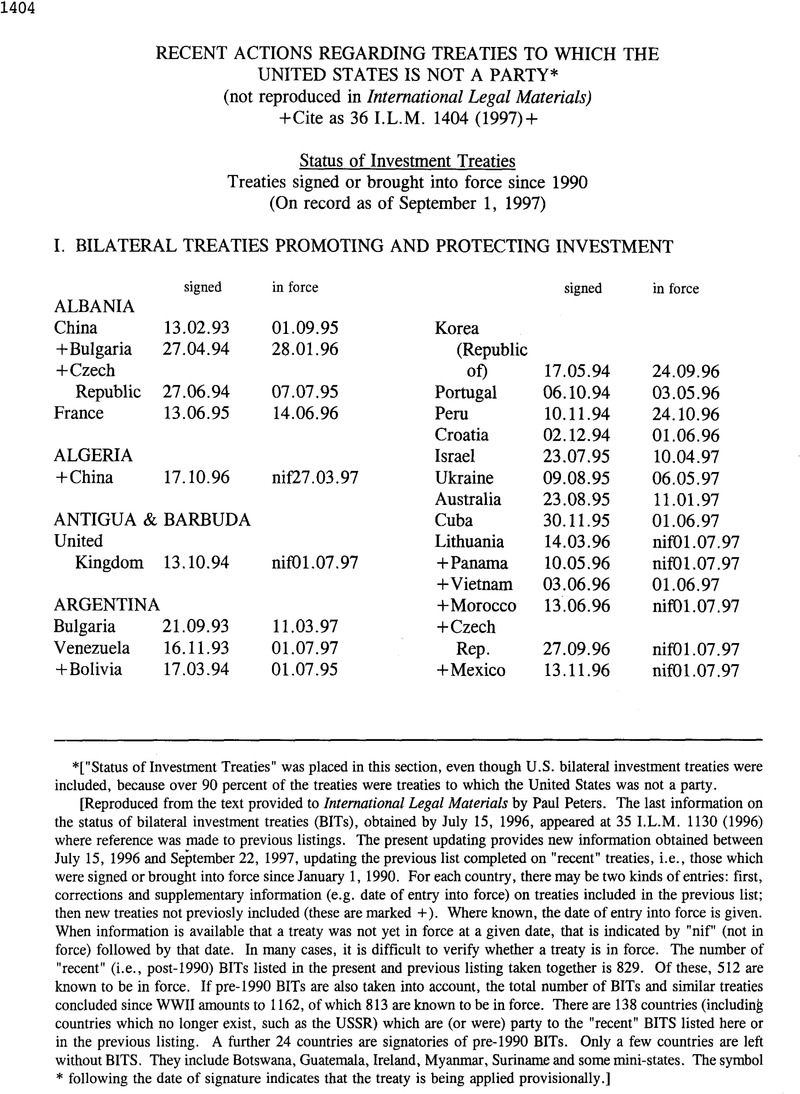Article contents
Recent Actions Regarding Treaties to which the United States is not a Party*
Published online by Cambridge University Press: 18 May 2017
Abstract

- Type
- Other
- Information
- Copyright
- Copyright © American Society of International Law 1997
Footnotes
[“Status of Investment Treaties” was placed in this section, even though U.S. bilateral investment treaties were included, because over 90 percent of the treaties were treaties to which the United States was not a party.
[Reproduced from the text provided to International Legal Materials by Paul Peters. The last information on the status of bilateral investment treaties (BITs), obtained by July 15, 1996, appeared at 35 I.L.M. 1130 (1996) where reference was made to previous listings. The present updating provides new information obtained between July 15, 1996 and September 22, 1997, updating the previous list completed on “recent” treaties, i.e., those which were signed or brought into force since January 1, 1990. For each country, there may be two kinds of entries: first, corrections and supplementary information (e.g. date of entry into force) on treaties included in the previous list; then new treaties not previosly included (these are marked +). Where known, the date of entry into force is given. When information is available that a treaty was not yet in force at a given date, that is indicated by “nif” (not in force) followed by that date. In many cases, it is difficult to verify whether a treaty is in force. The number of “recent” (i.e., post-1990) BITs listed in the present and previous listing taken together is 829. Of these, 512 are known to be in force. If pre-1990 BITs are also taken into account, the total number of BITs and similar treaties concluded since WWII amounts to 1162, of which 813 are known to be in force. There are 138 countries (including countries which no longer exist, such as the USSR) which are (or were) party to the “recent” BITS listed here or in the previous listing. A further 24 countries are signatories of pre-1990 BITs. Only a few countries are left without BITS. They include Botswana, Guatemala, Ireland, Myanmar, Suriname and some mini-states. The symbol * following the date of signature indicates that the treaty is being applied provisionally.]
References
* [“Status of Investment Treaties” was placed in this section, even though U.S. bilateral investment treaties were included, because over 90 percent of the treaties were treaties to which the United States was not a party.
[Reproduced from the text provided to International Legal Materials by Paul Peters. The last information on the status of bilateral investment treaties (BITs), obtained by July 15, 1996, appeared at 35 I.L.M. 1130 (1996) where reference was made to previous listings. The present updating provides new information obtained between July 15, 1996 and September 22, 1997, updating the previous list completed on “recent” treaties, i.e., those which were signed or brought into force since January 1, 1990. For each country, there may be two kinds of entries: first, corrections and supplementary information (e.g. date of entry into force) on treaties included in the previous list; then new treaties not previosly included (these are marked +). Where known, the date of entry into force is given. When information is available that a treaty was not yet in force at a given date, that is indicated by “nif” (not in force) followed by that date. In many cases, it is difficult to verify whether a treaty is in force. The number of “recent” (i.e., post-1990) BITs listed in the present and previous listing taken together is 829. Of these, 512 are known to be in force. If pre-1990 BITs are also taken into account, the total number of BITs and similar treaties concluded since WWII amounts to 1162, of which 813 are known to be in force. There are 138 countries (including countries which no longer exist, such as the USSR) which are (or were) party to the “recent” BITS listed here or in the previous listing. A further 24 countries are signatories of pre-1990 BITs. Only a few countries are left without BITS. They include Botswana, Guatemala, Ireland, Myanmar, Suriname and some mini-states. The symbol * following the date of signature indicates that the treaty is being applied provisionally.]
- 1
- Cited by


